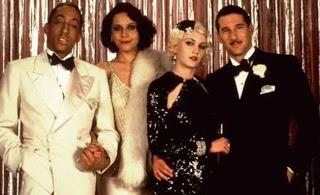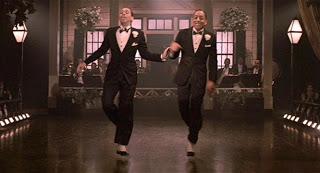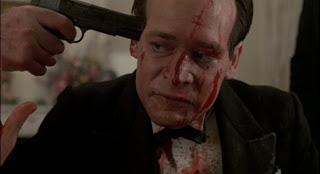
The Cotton Club (1984) must have seemed like asafe bet to Francis Ford Coppola after the nightmare of Apocalypse Now and his experimental One from the Heart and Rumble Fish. Instead it became a fiasco; Coppola clashed with his old nemesis Robert Evans, a rampaging budget forced the filmmakers to enlist some unorthodox financiers (including arms dealer Adnan Khashoggi), and to top everything off, co-producer Roy Radin was murdered during production. Then Coppola's version was heavily cut by Orion Pictures, released to theaters, received decidedly mixed and flopped - another in Coppola's line of Eighties misfires.
It's a real shame, because The Cotton Club has all the material for a classic. Yet, whether one blames the chaotic production, clashing visions of director, producer and studio or Coppola's increasingly erratic talents, it's an intermittently intriguing mess.
It's 1928 and Dixie Dwyer (Richard Gere) is a rising coronet player in Harlem. After saving the life of gangster Dutch Schultz (James Remar), he's invited to play at the Cotton Club. The Cotton Club, run by Schultz's boss Owney Madden (Bob Hoskins), is a legendary establishment where all-black musicians perform for exclusively white audiences. Dwyer falls for showgirl Vera (Diane Lane) who happens to be Dutch's moll; his brother Vincent (Nicolas Cage) becomes ensnared in the Underworld, to both of their detriment. Dixie becomes a Hollywood star, but finds that he can't be rid of the Mob so easily.

The Cotton Club's basic problem seems baked into the premise. With all the sensitivity and wisdom expected of 1980's Hollywood, the filmmakers take a setting mostly populated by African-Americans and enlist white protagonists, on the assumption that viewers won't cotton to what one Orion chief allegedly termed "black stuff." Dixie Dwyer never could have gotten a gig as a white musician there, any more than your average black man could have been a member. This seems less a comment on the obvious hypocrisy of the 1920s entertainment world than of a modern movie system still unequipped to handle such a sensitive topic.
Indeed, Cotton Club most often comes to life during its musical numbers. Coppola brilliantly recreates the look and feel of '20s Harlem, with a talented array of singers and dancers performing some heartstopping musical numbers. It's here that the movie's chief delights reside: a tap dance duet between Sandman Williams (Gregory Hines) and his brother (Maurice Hines), celebrities like Gloria Swanson (Diane Venora) and Cab Calloway (Larry Marshall) brushing shoulders with real mobsters Schultz, Madden and Lucky Luciano (Joe Dallesandro). These scenes, backed by John Barry's original score and period tunes, have spark, style and energy that alone make the movie worthwhile.
Unfortunately, Coppola and screenwriter William Kennedy spend way too much time on Dixie and Vera's dull romance, or the overcooked and under-explained gangster story. The latter features so many subplots that it becomes almost unnavigable: the movie sets up a feud between Madden and black gangster Bumpy Rhodes (Laurence Fishburne) that it abruptly drops; Vincent causes problems with a botched hit and it's never clear who he's working for, or if he's working for his own, or why his bosses turn against him. There are stylish murder scenes, particularly a Godfather-esque montage which cuts between a mass gundown and a tap dance number, but the crime story ultimately proves unworthy of the time spent on it.

Richard Gere plays Dixie as a thoroughgoing mope. He looks the part of a musician-turned-actor, but spends most of the film sulking (the scene where he beats Vera on the dance floor is painful to watch), reacting and playing the coronet. Diane Lane fares a little better, snapping off some barbed dialog and a nice musical number of her own, but still feels undercooked. As a sop to the otherwise-backgrounded black performers, Gregory Hines and Lonette McKee (as a dancer) receive a romance that's more compelling, yet still feels like the residue of a more thorough story arc. It reminds me of Ragtime, which keeps cutting away from Coalhouse Walker's more interesting plot to the antics of rich white people.
The supporting players are livelier. James Remar is all jovial sneers and barked threats, a compelling character turn that breathes life into otherwise dull stretches of film. Bob Hoskins plays his usual feral schemer, while Fred Gwynne is enjoyably cast against-type as his soft-spoken sidekick. One enjoys the colorful early roles for Nicolas Cage and Laurence Fishburne, who make more impact with a few minutes of screen time than either of the leads; or Gwen Verdon, who gets a nifty hoofing number near the end; or dependable character performances by Allen Garfield, Mark Magolis, John Ryan and Woody Strode.
The Cotton Club ends with a One from the Heart-style musical fantasy number, that's flashy, intricately staged but ultimately empty. The movie doesn't really this ending; after weighing us down in period detail and clotted plotting, the final flight of fancy seems a bit much. It's like Coppola's throwing up his hands and saying, "Well, this didn't work out - but at least we had fun!" Except, if you worked on this film, you probably didn't.

